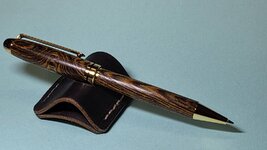Background:
So here is the ask... what recommendations do you all have for a finish?
Thank you in advance, and here are a few pictures...
David
- I am working on my first kitless pen that is wood with ebonite sleeves and section.
- The pen is constructed but has not been not finished
- The wood is Goncalo Alves or Tigerwood
- The barrel and cap are sanded to 800 grit
So here is the ask... what recommendations do you all have for a finish?
Thank you in advance, and here are a few pictures...
David












